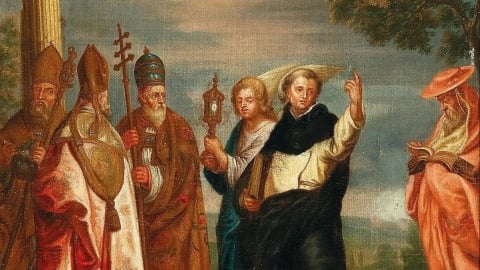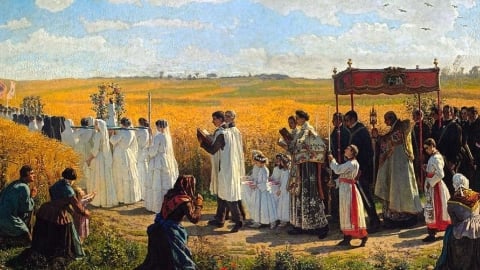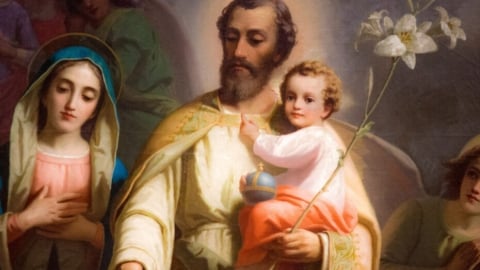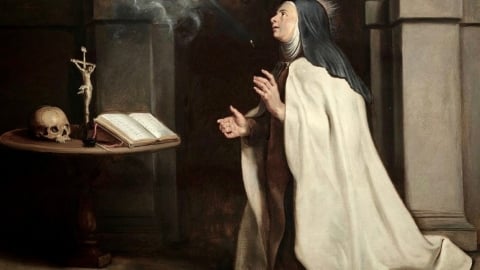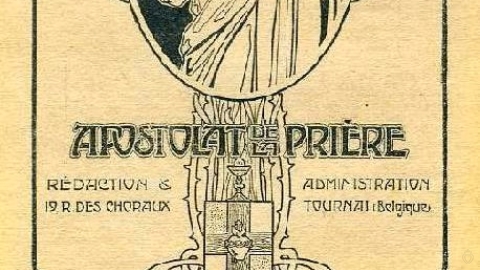Saint Pius X: Model for Priests - II

Bishop Sarto was consecrated in Rome by the Cardinal Vicar on Nov. 10, 1884. He took up his work as chief shepherd of a diocese that was in sore straits. It had defied the work and sacrifices of two predecessors. There was an underpaid, negligent clergy without respect of the people and lacking in self-confidence. Only one student was ready for ordination. The faith of the people was weak: many of the intellectuals were seduced by liberalism and freemasonry; the working people and peasants in large part were Socialists, and in general the practice of religion was confined to a few of the older women and children. An apostle was urgently needed.
The new Bishop lost no time in bringing a plan to fruition. He opened the seminary which had been closed for the past ten years. A few years later it had 146 carefully selected students. He organized religious instruction classes, and ordered a unit of the Confraternity of Christian Doctrine in every parish. The Bishop himself often took part in the teaching. He also could be found on many mornings in the confessional of the cathedral or in one of the parishes or missions in his diocese. In a short time Bishop Sarto won over his priests with his solicitude for them and his love for the souls of their people. The faithful in turn gave themselves wholeheartedly to the practices of their religion under the inspiring leadership of their chief shepherd. “Your new Bishop,” he told them, “is the poorest of all, but he has one ambition only-to see all the children under his care united in one large happy family, and under its shelter their souls will be safe.”
CARDINAL PATRIARCH OF VENICE
The See of Venice fell vacant in 1892. It was breathed about that Bishop Sarto would be elevated to the queen city of the Adriatic. But he himself effectively squelched such rumors and a year passed. He gave no more thought to the matter until, in May, 1893, he was informed officially that it was the express wish of Pope Leo XIII that he assume the duties of patriarch of Venice. On June 3, 1893, Bishop Sarto received official notice of his promotion to the See of Venice and was informed that he would be named a cardinal. He received the red hat from Leo XIII on June 15 and was formally confirmed as patriarch of Venice in a secret consistory held on the same day. “This,” the Pontiff pointed out, “will be to open to your zeal and charity a wider field of endeavor.”
The Venetians received Cardinal Sarto with loyalty and enthusiasm. He found in Venice all the problems that Mantua had posed, only magnified and intensified. His prodigious capacity for work, his great ability to plan and to organize, combined with his long experience as a pastor of souls were crowned with deep and lasting success in building up and vitalizing the faith and devotion of his people. Nothing escaped his zeal: the seminary, new parishes, pastoral visits, the press, church music, relations with the civil officials, public ceremonies and anniversaries. On the fourth Thursday of each month the Cardinal held a day of spiritual retreat for his priests at which he preached and gave the conferences and meditations. Then there were his beloved poor and the institutions that kept him penniless. “I was always poor wherever I have been,” he once remarked, “but here I am destitute.”
The Cardinal’s day was a full one. He arose early as he had done since boyhood. He made his preparation for Mass which was offered at six. Then followed thanksgiving and a cup of black coffee was brought to him by his sister. The Cardinal made his meditation and read his Breviary. At nine the business of the day was begun. He had no set hours for audiences; for he met visitors on any day and at any hour. At two o’clock there was a frugal lunch. After a brief siesta and a cup of coffee, the Cardinal transacted official business or went on a visitation of a parish, hospital or school. Sometimes this was made in the course of his accustomed walk, which on doctor’s advice, he rarely omitted. Toward evening he made a visit to the Blessed Sacrament and at nine after reciting the Rosary with his sisters and the members of his household, the Cardinal partook of his dinner. It was always light: some meat and vegetables, bread and wine. Going to his private office, the Cardinal finished his prayers and engaged in reading and writing until midnight when he retired. And so another novena of years passed. The Cardinal had spent nine years in each of his previous assignments: Tombolo, Salzano, Treviso, Mantua. Now in his ninth year in Venice, word was brought to him of the death of Pope Leo XIII. Six days later on July 26, 1903, Cardinal Sarto left for Rome and the conclave. The rest is history.
“I TAKE THE NAME OF PIUS”
Cardinal Gibbons used to tell how it was the humility and holiness of the Patriarch of Venice which decided the issue in the election of Pope Pius X on Aug. 4, 1903. Despite his protests and tears he was chosen to succeed the great Leo XIII. It was characteristic of the new Pope that he chose the name Pius as he said, “in memory of the holy Pontiffs whose patronage I gravely need, and who have withstood bitter persecutions against the Church and themselves.” Pius X expected trials and suffering as the vicar of Christ, who was Himself never a stranger to suffering. Of such is the essence of the priestly vocation. “We do not enter the priesthood to seek a life of comfort. . . . To be obliged to labor constantly and to be a priest,” he wrote, “is one and the same thing.”
The eleven years’ reign of Pius X can well be regarded as one of the most fruitful, and in its effects the most lasting in the long history of the Papacy. Much of what the Church enjoys today a half century later in the diverse fields of its work can be traced to the fertile mind and practical initiative of Pope Pius X. Whether it affects the inner administration of the Church: the Roman congregations, the Code of Canon Law, the reform of seminaries, or matters of reorganization: church music, Catholic Action, catechetical instruction through the Confraternity of Christian Doctrine, Eucharistic decrees, the deathblow to Modernism-all reflect a Pope of action. Throughout all his pronouncements and achievements, one focal point stands out clear and impelling; it is the essential and necessary work of the priest, as a man of God, in the divine economy of salvation.
Pope Pius saw this even more clearly when he became head of the Church. His expressed ideal was “to restore all things in Christ.” To achieve this, the Pope affirmed that he must have good priests, well trained in approved seminaries. The many decrees and reforms of the Pontiff throughout his reign bear directly on the priests and bishops of the Church. His solicitude for them was only exceeded by his paternal love. And still, Pius X knew how to temper love with justice. He could be severe and very firm when the occasion warranted. One day a priest who had been remiss in his duties was told by the then Bishop of Mantua that he must do a period of penance away from his parish. When the priest demurred, the Bishop looked at him firmly yet kindly and said, “Now, Father, you will do this for me, to please me; because it would make me very unhappy if you would not be able to say Mass.”
“THE EXHORTATION TO THE CLERGY”
Just what the priesthood meant to Pius X can be seen in the “Exhortation to the Catholic Clergy” which he wrote in 1908 on the fiftieth anniversary of his ordination. This classic text is an incomparable exposition of the nature of the priesthood, its ideals, its dangers and rewards, and the means of perfection for the priests of today. Looking back over the span of fifty years as a priest, the venerable Pontiff, working in the quiet of his study in the Vatican, drew a picture of the good shepherd of souls. It is a description made unconsciously of the priestly virtues which he had preserved all his life.
The priest, according to the “Exhortation,” is like a mirror in which the faithful can easily see and imitate his virtues and fervor. “It is not possible for a priest to be good or bad alone,” he wrote, with the influence of the priest on others in mind. “The character and life of a priest cannot but have lasting effect on his people.” The high vocation of the priesthood, therefore, demands a holiness of life beyond the ordinary. This is fostered and preserved in the soul of the priest by the graces received in the Holy Sacrifice of the Mass, in daily meditation, spiritual reading, and through mortification of the senses and detachment from this world.
The saintly Pontiff warned his priests against what later writers have called “the heresy of good works.” Priests are obliged to cultivate the interior virtues. Pius X condemned the view that “the merit of a priest should consist in being entirely occupied in working for others, and thus pay little heed to the virtues which perfect himself.” The Pope demanded that “the priest must go out among his people,” and he shall not wait for them to come to him. This is the burden of the message of St. Pius X to the priests of his day and of all time.
On Aug. 20, 1914, broken hearted over a world in flames and carnage, Pope Pius X died. Like a weary laborer in the fields, who falls worn out with arms filled with sheaves of a full harvest, the saintly Pope gave over his life to God.
For years faithful clients and friends have invoked Saint Pius X in their troubles and necessities; and they have not been disappointed. The Church herself has issued official approval of the intercessory power of a Saint of God in the documents of beatification and canonization and, as someone has affirmed, in the “almost embarrassing” number of miracles that have been offered in testimony to the power of Pius X.
Like the little Therese of Lisieux, whose cause toward sainthood was introduced by him, Pope Pius X is already “spending his heaven in doing good on earth.” Whenever Saint Pius X is invoked, none will have greater cause to rejoice than the priests who always shared so fully in his tender charity.
